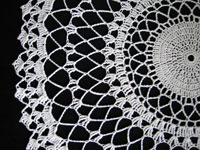Crochet
August 2003
Introduction
This summer I had some time on my hands, several balls of Coats
Knit-Cro-Sheen
white mercerized cotton cord, a nickel plated steel No. 1 crochet hook my grandmother gave me in the 1960's, and links for vintage crochet patterns. So, rather than worry about how hard the recession was hitting part time workers like me, I used the time to get reacquainted with crocheting.
Although crochet and embroidery were the kinds of needlework I learned as a child, I had been mostly knitting since the early 1970's. We had a cool spring, so even in June it felt good to be knitting (and wearing!) wool socks and mittens. I came across the crochet thread while sorting through craft supplies. I knitted a swatch or two, then knit some small
coin purses. They started plain, then advanced to an envelope shape with a flap and neck cord. Some ended up with crocheted edges while some got trimmed with beads.
I remembered looking through the lace curtains (filet crochet) that my father's mother made for their kitchen door when they still had the dairy farm. She almost always was working on something when we visited and I enjoyed going through the leaflets and books of patterns she had.
Getting started

|
In the spring I crocheted a small motif from some lace weight wool. Even though I just let my fingers remember what to do instead of following a pattern, it was pretty when blocked. I like working in the round anyway, so, I found a knitting and crochet dictionary from Mon Tricot which I got in the late 1960's or early 1970's and tried a few motifs.
Low and behold, it laid flat even without blocking. I remembered making doilies that curled, which my grandmother said was from crocheting with too tight a tension. Maybe it is because of weakened muscles from mitochondrial disease. Perhaps I picked it up from learning how to make loose casting on and off from knitting. Maybe I am just older and wiser. Anyway, tension doesn't seem to be a problem any more.
|
Filet crochet
Although the motifs were fun to get started, they weren't quite enough. Time to search the web. I found a
pattern from 1919
for an Art Deco-looking floral edging. Although I was really looking for a doily, it was a good place to start. I needed a review of how to make increases and decreases, then went ahead. It took an entire ball and part of another to make four repeats. When I washed and blocked it, it was the width of a doorway, so I attached it to a dowel and hung it over a doorway in my apartment.
Doilies
A doily, which I have also seen spelled doylie, d'Oylie, etc. is a mat that is used to set a plate, vase, candlestick, or other object on ostensibly to protect the surface of wood furniture. From that utilitarian beginning evolved a variety of patterns. I particularly like the ones that look like snow flakes.
The two pictured below were titled
Two Crocheted Doilies, Corticelli, 1918. In the
Knit-Cro-Sheen
they came out 21 inches in diameter when blocked but not stretched. They were too big to fit on my scanner, so I photographed them on a piece of navy wool cloth.
I found a number of sites on the web dedicated to preserving the old patterns, for example http://www.angelfire.com/folk/celtwich/ Celt's Vintage Crochet which has since become a
Yahoo! Group.
August 2, 2003
threads home
>
crochet
> Summer 2003



